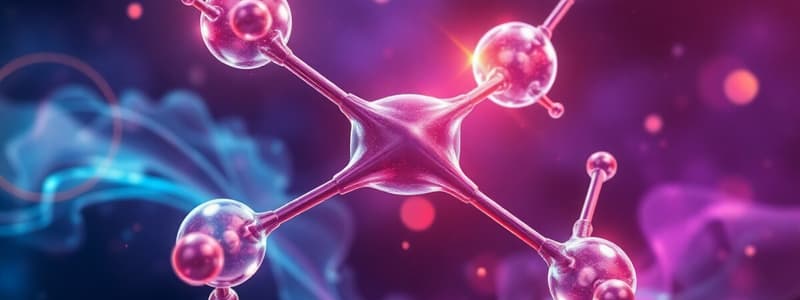Podcast
Questions and Answers
What type of bond is formed by end-to-end orbital overlap?
What type of bond is formed by end-to-end orbital overlap?
- Triple bond
- Sigma bond (correct)
- Double bond
- Pi bond
How many sigma bonds are formed in sp2 hybridization?
How many sigma bonds are formed in sp2 hybridization?
- Two sigma bonds and two Pi bonds
- Four sigma bonds
- One sigma bond and three Pi bonds
- Three sigma bonds and one Pi bond (correct)
Which of the following carbon types is bonded to three other carbon atoms?
Which of the following carbon types is bonded to three other carbon atoms?
- Secondary carbon (2°)
- Quaternary carbon (4°)
- Tertiary carbon (3°) (correct)
- Primary carbon (1°)
What suffix indicates a double bond in IUPAC nomenclature?
What suffix indicates a double bond in IUPAC nomenclature?
Which prefix is used when naming a molecule with substituents or branching?
Which prefix is used when naming a molecule with substituents or branching?
In a straight chain hydrocarbon, how is the chain numbered?
In a straight chain hydrocarbon, how is the chain numbered?
How does one identify a quaternary carbon in a compound?
How does one identify a quaternary carbon in a compound?
What is the correct order of elements for naming a hydrocarbon?
What is the correct order of elements for naming a hydrocarbon?
What term describes the positioning of substituents when they are on adjacent carbon atoms in a benzene ring?
What term describes the positioning of substituents when they are on adjacent carbon atoms in a benzene ring?
In naming a compound with multiple functional groups, which functional group is given the position number 1 when assigning priorities?
In naming a compound with multiple functional groups, which functional group is given the position number 1 when assigning priorities?
What type of isomerism occurs when molecules have the same molecular formula but differ in the connectivity of their atoms?
What type of isomerism occurs when molecules have the same molecular formula but differ in the connectivity of their atoms?
What is the suffix used to indicate a double bond in an organic compound?
What is the suffix used to indicate a double bond in an organic compound?
When naming a compound with both double and triple bonds, which suffix comes first?
When naming a compound with both double and triple bonds, which suffix comes first?
Which prefix indicates a three-carbon cyclic compound?
Which prefix indicates a three-carbon cyclic compound?
What is the primary consideration when numbering the carbon chain in a molecule?
What is the primary consideration when numbering the carbon chain in a molecule?
In IUPAC nomenclature, how do you indicate the presence of a two-carbon branch?
In IUPAC nomenclature, how do you indicate the presence of a two-carbon branch?
Flashcards
What is organic chemistry?
What is organic chemistry?
The study of hydrocarbons (compounds made of carbon and hydrogen) and their derivatives.
What is covalent bonding?
What is covalent bonding?
A type of chemical bond where electrons are shared between atoms.
What is a sigma bond?
What is a sigma bond?
A covalent bond formed by the direct overlap of atomic orbitals along the internuclear axis (end-to-end).
What is a pi bond?
What is a pi bond?
Signup and view all the flashcards
What is a primary carbon (1°)?
What is a primary carbon (1°)?
Signup and view all the flashcards
What is a secondary carbon (2°)?
What is a secondary carbon (2°)?
Signup and view all the flashcards
What is a tertiary carbon (3°)?
What is a tertiary carbon (3°)?
Signup and view all the flashcards
What is a quaternary carbon (4°)?
What is a quaternary carbon (4°)?
Signup and view all the flashcards
What are isomers?
What are isomers?
Signup and view all the flashcards
What are structural isomers?
What are structural isomers?
Signup and view all the flashcards
What are positional isomers?
What are positional isomers?
Signup and view all the flashcards
What are chain isomers?
What are chain isomers?
Signup and view all the flashcards
What are functional isomers?
What are functional isomers?
Signup and view all the flashcards
What is metamerism?
What is metamerism?
Signup and view all the flashcards
What are ring-chain isomers?
What are ring-chain isomers?
Signup and view all the flashcards
What is homolytic fission?
What is homolytic fission?
Signup and view all the flashcards
What is heterolytic fission?
What is heterolytic fission?
Signup and view all the flashcards
What are free radicals?
What are free radicals?
Signup and view all the flashcards
Word Root (Hydrocarbon Naming)
Word Root (Hydrocarbon Naming)
Signup and view all the flashcards
Number (Hydrocarbon Naming)
Number (Hydrocarbon Naming)
Signup and view all the flashcards
1° Suffix (Hydrocarbon Naming)
1° Suffix (Hydrocarbon Naming)
Signup and view all the flashcards
2° Prefix (Alkyl Group Naming)
2° Prefix (Alkyl Group Naming)
Signup and view all the flashcards
Word Root (Alkyl Group Naming)
Word Root (Alkyl Group Naming)
Signup and view all the flashcards
Cyclo- Prefix (Cyclic Hydrocarbons)
Cyclo- Prefix (Cyclic Hydrocarbons)
Signup and view all the flashcards
Numbering Carbons (IUPAC)
Numbering Carbons (IUPAC)
Signup and view all the flashcards
IUPAC Nomenclature
IUPAC Nomenclature
Signup and view all the flashcards
Multiple Double/Triple Bonds
Multiple Double/Triple Bonds
Signup and view all the flashcards
Alphabetical Order (Double/Triple Bonds)
Alphabetical Order (Double/Triple Bonds)
Signup and view all the flashcards
Alkyl Group Naming
Alkyl Group Naming
Signup and view all the flashcards
Priority of Functional Groups
Priority of Functional Groups
Signup and view all the flashcards
Substituted Benzenes
Substituted Benzenes
Signup and view all the flashcards
Naming Ethers
Naming Ethers
Signup and view all the flashcards
Naming Esters
Naming Esters
Signup and view all the flashcards
Study Notes
Organic Chemistry Basics
- Organic chemistry is the study of hydrocarbons and their derivatives.
- The most common bonding in organic compounds is covalent bonding.
- Covalent bonds are classified into sigma and pi bonds based on orbital overlap.
- A sigma bond is formed by end-to-end orbital overlap and is stronger than a pi bond.
- A pi bond is formed by sideways orbital overlap and is weaker than a sigma bond.
- In a carbon atom with multiple bonds, the first bond is a sigma bond; subsequent bonds are pi bonds.
Hybridization
- sp3 Hybridization: occurs when a carbon atom forms four sigma bonds.
- sp2 Hybridization: occurs when a carbon atom forms three sigma bonds and one pi bond.
- sp Hybridization: occurs when a carbon atom forms two sigma bonds and two pi bonds.
Types of Carbon
- Primary carbon (1°): A carbon atom bonded to one other carbon atom.
- Secondary carbon (2°): A carbon atom bonded to two other carbon atoms.
- Tertiary carbon (3°): A carbon atom bonded to three other carbon atoms.
- Quaternary carbon (4°): A carbon atom bonded to four other carbon atoms.
IUPAC Nomenclature Rules
- The order for naming a molecule follows these rules:
- 2° prefix (for substituents/branching). Position indicated by a number.
- 1° prefix (for closed chains, "cyclo-" prefix).
- Word Root (number of carbons in the main chain).
- 1° suffix (linkages: single, double, or triple bonds).
- Single bond: -ane
- Double bond: -ene
- Triple bond: -yne
- 2° suffix (functional group).
Straight Chain Hydrocarbon Naming
- The main chain is the longest carbon chain.
- Numbering starts at the end closest to a double or triple bond.
- The IUPAC name follows this structure: Word root-Number-1° suffix.
- Example: C-C=C-C is But-2-ene.
Carbon Chain Naming
- The longest carbon chain determines the word root.
- 2° prefixes are used for branches, numbered.
- Word root is for the main chain.
- 1° suffix indicates linkages (single, double, or triple bonds).
- 2° suffix indicates the functional group.
Naming Organic Compounds: Introducing IUPAC Nomenclature
- IUPAC provides a standardized naming system for organic compounds.
- Alphabetical order is prioritized for prefixes and suffixes.
- The term "hex" represents a six-carbon chain.
- Double and triple bonds are denoted by "-ene" and "-yne", respectively, with numbering for position.
- For multiple "enes" or "ynes", use prefixes like "di," "tri."
- Alphabetical order determines priority between "-ene" and "-yne" at the same position.
Understanding 'Tie-Breakers'
- Alphabetical order of suffixes ("ene" before "yne") resolves tie-breaking situations with double and triple bonds.
- Same applies to branching with functional groups at different positions.
- Prefixes "di," "tri," etc., denote multiple branches.
Naming Branched Chain Hydrocarbons
- Identify the longest carbon chain (including multiple bonds) as the main chain.
- Number the main chain from the end giving the lowest numbers to branches.
- Name branches using "-yl" (methyl, ethyl, etc.).
Naming Closed-Chain Hydrocarbons
- The "cyclo" prefix denotes closed rings.
- The number of carbons in a ring is used in the root name (e.g., cyclopropane).
- Lowest number assigned to the double bond in a closed chain.
- Branches are named, the cyclo prefix is added, followed by the ring root, and the suffix for the carbon-carbon bond type.
- Example: 1-methylcyclopropane.
Naming Organic Compounds
- Rules for numbering carbons: Start from the end giving the lowest number to functional groups. Highest priority functional groups determine lowest numbering position.
- Highest priority functional groups:
- Carboxylic acids
- Aldehydes
- Ketones
- Alcohols
- Alkenes
- Alkynes
- Closed chain rules: Use "cyclo-" followed by the corresponding alkane's name, numbering from the functional group with the highest priority
- Functional groups and common names:
- Aldehydes (-CHO): Suffix "al," e.g., propanal (propyl aldehyde)
- Ketones (-C=O): Suffix "one," e.g., butanone (methyl ethyl ketone)
- Alcohols (-OH): Suffix "ol," e.g., ethanol (ethyl alcohol)
- Carboxylic acids (-COOH): Suffix "oic acid," e.g., ethanoic acid (acetic acid)
- Ethers (R-O-R'): Alkoxyalkane, e.g., methoxypropane.
- Esters: Alkyl alkanoate, e.g., ethyl ethanoate.
- Halides (X): Haloalkane, e.g., 2-bromopropane.
Substituted Benzenes
- Common and IUPAC naming: -Phenol (hydroxybenzene), Aniline (aminobenzene), Nitrobenzene, Toluene (methylbenzene), Benzoic acid, Acetophenone (methyl phenyl ketone, acetylbenzene).
Positional Isomers
- Ortho, Meta, Para:
- Ortho: Adjacent carbons
- Meta: One carbon apart
- Para: Opposite carbons
- Naming substituted benzenes: Numerical or ortho, meta, para prefixes are used.
- Priority rules: Highest priority functional group is the main group, numbering from it.
Naming Organic Compounds (continued)
- Priority order for functional groups is crucial.
- Alcohols have higher priority than halogens. Main chain includes the alcohol-containing carbon at the lowest number.
- Branches are named alphabetically.
- Example: 1-bromo-5-chloro-4-methylhexan-3-ol.
- Aldehyde has higher priority than ketone in the chain selection.
- Example: 3-oxo-2-methylhexanal.
Isomerism
- Isomers have the same molecular formula but different structures/arrangements.
- Structural isomers: Different connectivity of atoms
- Stereoisomers: Same connectivity, different spatial arrangement.
Structural Isomerism
- Chain isomerism: Different chain lengths.
- Position isomerism: Different positions of functional groups/substituents.
- Functional isomerism: Different functional groups.
- Metamerism: Different alkyl groups attached to the functional group.
- Ring-chain isomerism: Ring or chain structure.
- Examples of chain isomers: butane/2-methylpropane, pentane/2-methylbutane, etc.
- Examples of positional isomers: 1-chloropropane/2-chloropropane, but-1-ene/but-2-ene. etc.
- Examples of functional isomers: ethanol/methoxyethane, propanal/propanone. etc.
- Examples of metamers: methoxypropane/ethoxyethane, ethyl propyl ether/diethyl ether.
- Examples of ring-chain isomers: cyclopropane/propene.
General Organic Chemistry (GOC)
- GOC studies organic compounds' structures, bonding, properties, and reactions, especially those with functional groups.
- Bond fission: Breaking covalent bonds between atoms.
- Heterolytic fission: Electrons from the bond transferred to one atom, forming ions.
- Homolytic fission: Each atom receives one electron from the bond, forming free radicals.
- Heterolytic fission common in polar bonds, homolytic fission common in nonpolar bonds, or with light or heat energy.
- Free radicals are reactive due to unpaired electrons.
Key Points about Bond Fission (continued)
- Heterolytic fission forms ions (cation and anion).
- Homolytic fission forms free radicals.
- Polar solvents favour heterolytic fission, non-polar favour homolytic or heat/light energy.
Studying That Suits You
Use AI to generate personalized quizzes and flashcards to suit your learning preferences.




